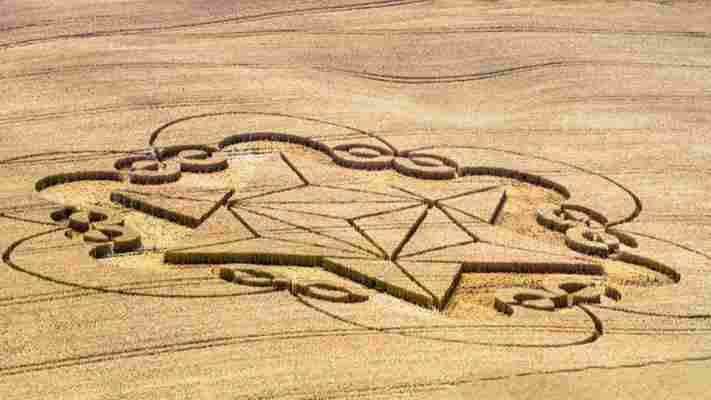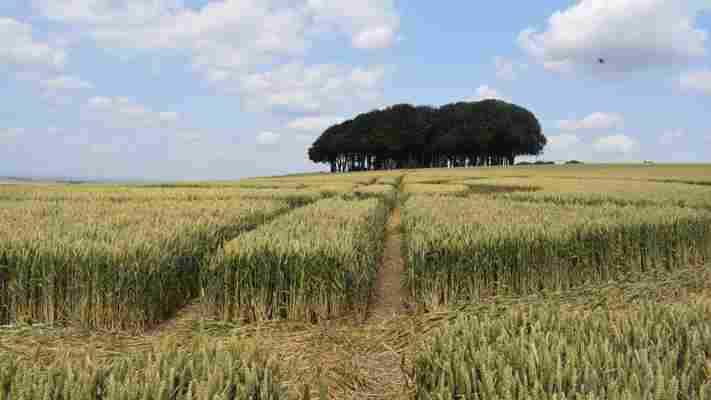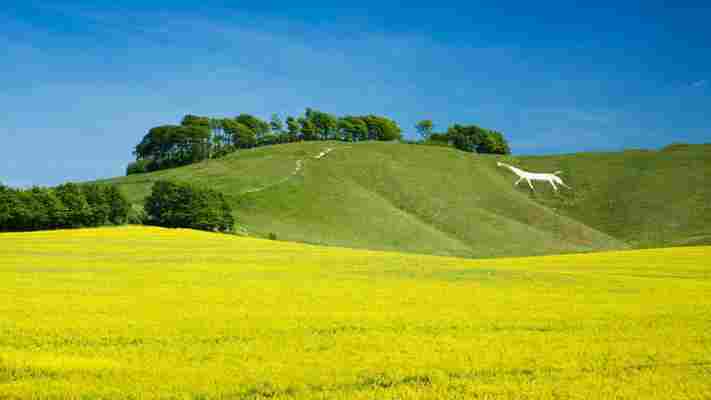Ears of wheat prickled my shins and the sun beat down on my neck as I trudged through the tractor lines of a golden field on Wiltshire's Hackpen Hill. It was August – the height of crop circle season – and I'd been directed here by frenzied online reports of a new formation, which had appeared, as they are wont to do, overnight; apparently unseen by observers. From the ground, I could make out nothing but intersecting lines of trampled wheat – but photographed from above the pattern resembled a crosshair.

Was this the nexus for some kind of potent Earth energy? Or, terrifyingly, a target for extra-terrestrial weaponry? In this instance, something more mundane. "That's the logo of the Barge Inn down in Honeystreet," chuckled a fellow visitor, a potbellied man in a Dark Side of the Moon T-shirt. "Probably man-made, this one."
Although such formations have appeared worldwide, from California to the rice paddies of Indonesia , south-west England is the world capital of crop circles. They are particularly concentrated in the county of Wiltshire, where a treasure trove of ancient history includes the Neolithic sites of Stonehenge and Avebury – both crop circle hotspots.
Carving artwork into the landscape is an age-old tradition in these parts; chalk horses adorn eight hillsides in Wiltshire; while the UK's oldest geoglyph, the stunning Bronze Age Uffington White Horse , sits just across the border in Oxfordshire. Reports of mysterious patterns appearing in wheat, barley and corn fields in the area began to circulate in the 1970s, but it was in the late '80s that the phenomenon exploded. Circles began to appear more frequently and became far more ornate: some resembled trippy fractals ; others rune-like hieroglyphs; others stylised animals recalling those of the Nazca Lines in Peru.

The county of Wiltshire is home to around 80% of the UK's crop circles (Credit: Daniel Stables)
The intricacy and size of the formations, coupled with the fact that they would appear overnight, seemingly out of nowhere, baffled locals and farmers alike. In 1996, a crop circle appeared opposite Stonehenge depicting a mathematical fractal called a Julia set; a similar formation that emerged on Milk Hill in 2001 was one of the largest ever, stretching 900ft. A 2008 formation near the Iron Age hill fort of Barbury Castle required decoding by an astrophysicist , who concluded that it was a geometric representation of the first 10 digits of pi.
The phenomenon peaked in the 1990s and early 2000s, but continues today; an average of 30 crop circles appear each year in the UK, around 80% of them in Wiltshire. Formations reported in 2021 have included a hexagonal pattern overlaid with spirals in Avebury, and a pattern of concentric "bubbles" in Tidworth Down. Crop circle season usually begins at the end of May, with the first ripening of the barley, and ends by September when the harvesting of the crops cuts away the circle canvasses.
You may also be interested in: • The UK's forgotten 'fifth nation' • The shipwreck that changed the world • England's disputed national treasure
As the number of crop circles has grown, so has the mythology surrounding them. Some invoke the theory of ley lines : mystical seams of spiritual energy that intersect at sacred sites like Avebury and Stonehenge. Others claim that the circles are created by an extra-terrestrial intelligence attempting to warn humanity about climate change, nuclear war and similar existential threats. One even appeared in May 2020 in the shape of a coronavirus, leading to feverish speculation that crop circles are trying to give us clues about immunology and Covid-19.
Among those who discount the alien hypothesis, a common theory is that human circle makers "tap into" some kind of collective consciousness, perhaps explaining the prevalence in crop circles of universal mathematical patterns that also occur in nature – the fractal branching of snowflakes and blood vessels and the spiralling shells of molluscs, for example.
A common theory is that human circle makers "tap into" some kind of collective consciousness, perhaps explaining the prevalence in crop circles of universal mathematical patterns that also occur in nature
The community of seekers who devote their time to researching the paranormal possibilities of crop circles are known as "croppies". Eminent among them is Monique Klinkenbergh, who left behind a life in art publishing in the Netherlands to establish the Crop Circle Exhibition & Information Centre , in the Wiltshire village of Honeystreet. This tiny hamlet has become an unlikely hub for paranormal research; in addition to Klinkenbergh's exhibition centre, it is home to the Barge Inn , where croppies gather to swap reports of new crop circles and speculate on their origins.

Carved into the chalky hillside, the Cherhill white horse is the second oldest of Wiltshire's iconic horse figures (Credit: James Osmond/Getty Images)
Klinkenbergh's life changed in 2007 when she saw a picture of an ornate geometric crop circle. "Having a background in art, I failed to understand how 13-fold geometry could appear in a cornfield in such a short time span, in darkness, on uneven terrain and unnoticed," she said. "The more I learnt about the phenomenon, the more I was amazed. Credible people were witnessing incredible things." She has now devoted her time to the study of one of England's most enduring mysteries.
Reports of cameras suddenly breaking and car engines turning themselves on in the vicinity of crop circles are common. "I've seen several orbs of light," said Klinkenbergh. "I once saw a UFO; not a classic flying saucer, but a strange object hanging stationary in the air and eventually flying away with enormous speed. According to locals, these lights and strange objects have been witnessed for centuries."
Then there are the sceptics. As long ago as the 19th Century, scientist John Rand Capron described basic flattened circles in crops and suggested they could be caused by "cyclonic wind", a theory later echoed by Stephen Hawking , but this does not explain the complex formations more common today. "The true course of meteorological research got overwhelmed by the efforts of hoaxers," the Tornado and Storm Research Organisation (TORRO) told me in a statement. "All the complex circles of the last 30 years are manmade."
According to locals, these lights and strange objects have been witnessed for centuries
Foremost among the hoaxers are Doug Bower and Dave Chorley, who in 1991 claimed to have created hundreds of circles using ropes to measure the formations and wooden planks to flatten the crops. They demonstrated this technique for waiting television crews – but not everyone is convinced by their evidence. "Some of the formations are so intricate and so big that I can't see two people doing them," said Tim Carson, a farmer in the Wiltshire village of Alton Barnes. "Some of them are 300m long and they go over the brow of a hill. How would you know the other person's doing the same thing you are?"
Wiltshire is also home to the Neolithic sites of Stonehenge and Avebury (pictured) – both crop circle hotspots (Credit: James Osmond/Getty Images)
Carson is more qualified than most to comment, having seen hundreds of crop circles appear in his fields – ravaging thousands of pounds worth of crops in the process. It all began in 1990, when a famous formation known as the Eastfield Pictogram appeared overnight in one of Carson's fields. It caught the attention of the world's press, and a photograph of the crop circle was even used as cover art by Led Zeppelin. "Within days we had thousands of people turning up," Carson said. "We charged people a pound a time, had keyrings and T-shirts made. It became probably our most profitable quarter of an acre ever."
To some, this supports the theory that crop circles are nothing more than a money-making enterprise between the hoaxers, farmers and photographers. The process was explained to me as follows by circle maker Dene Hine: "Circle makers make a formation; drone pilot flies the formation; [they then use] social media platforms to spam all the pages with videos. Each video can make £500 from YouTube alone."
Social media is not just a marketplace for the crop circle business. It is a battleground for the toxic, parasitic relationship between the croppies and the hoaxers: conjoined twins who profess to hate one another yet feed on the other for their existence. To the sceptical mind, after all, there would be no crop circles without the hoaxers. Yet, without the mystique and intrigue generated by the croppies, it's hard to imagine the hoaxers would bother at all. Nevertheless, barbs are exchanged, and not just virtually; more than one croppie told me they had been physically threatened by hoaxers and photographers. "I've seen fistfights break out," said Kathy Rossellini, an energy healer and psychic medium who I met at the Crop Circle Exhibition & Information Centre. "But I don't get involved with all that. It's been hijacked by ego."
There is much that remains enigmatic about crop circles, even to farmers like Carson, who has tired of the whole thing and now deters visitors by cutting out any formations as soon as they appear. He spoke of watches stopping inside circles and recording equipment inexplicably failing during a visit from the BBC's Newsround in 1991. He has allowed companies including Nissan to build corporate crop circles in his fields for use in advertising, but claims that just a basic design took professionals 12 hours of daylight to produce, in contrast to the suggestion that hoaxers produce circles quickly in the dead of night.
Some hoaxers have claimed to be behind the crop circles, but the intricacy and size of the formations continues to baffle many people (Credit: Christopher Jones/Alamy)
"Some of the circles are mysterious, without doubt," he said. "Sometimes the crops appear woven, lying one way and another on top of each other. That would take hours and hours to do by hand."
What, then, to make of crop circles? Are they the work of human hands, driven by some emergent cosmic subconsciousness; aliens; hoaxers? Does it matter?
"Even in the manmade circles, a phenomenon exists, which for me is where the mystery lies," said Rossellini. "People say to me, 'Are they real?' Of course they are. You're standing in it."
Hidden Britain is a BBC Travel series that uncovers the most wonderful and curious of what Britain has to offer, by exploring quirky customs, feasting on unusual foods and unearthing mysteries from the past and present.
--
Join more than three million BBC Travel fans by liking us on Facebook , or follow us on Twitter and Instagram .
If you liked this story, sign up for the weekly bbc.com features newsletter called "The Essential List". A handpicked selection of stories from BBC Future, Culture, Worklife and Travel, delivered to your inbox every Friday.
